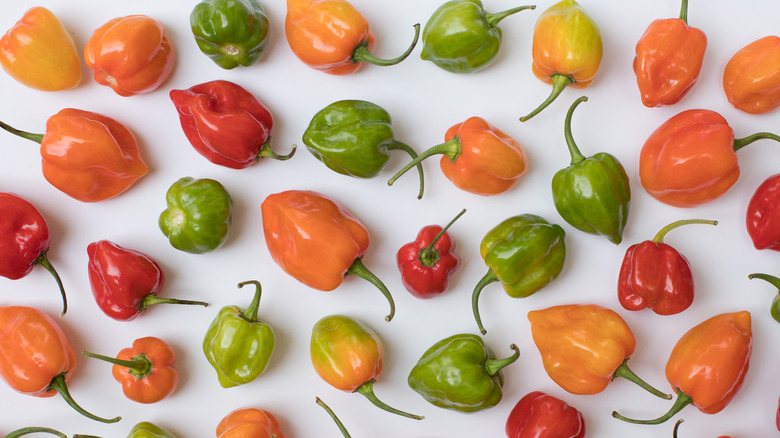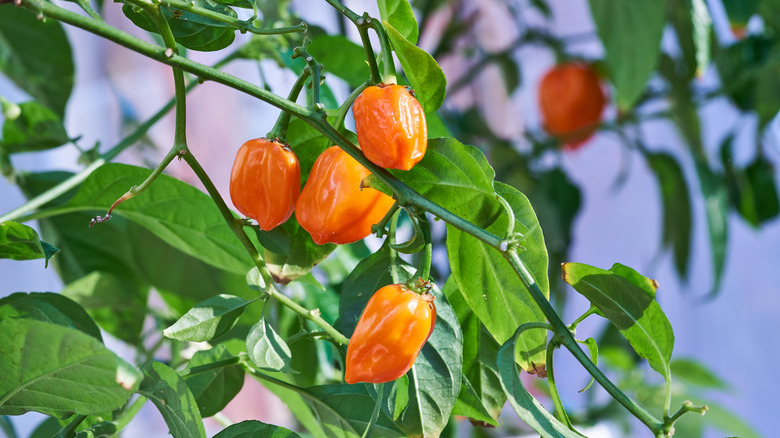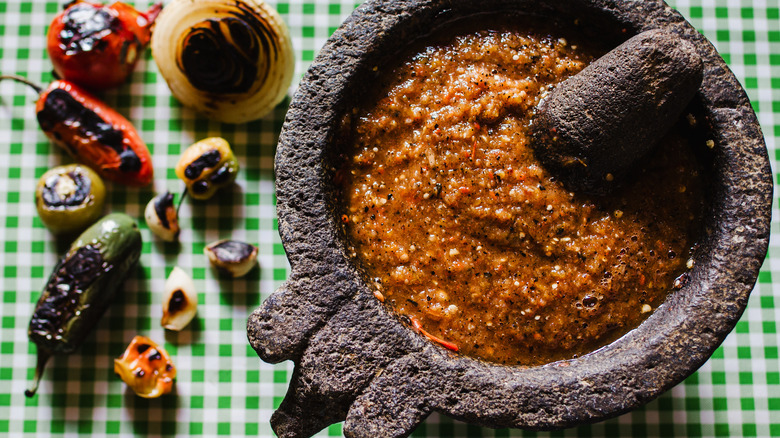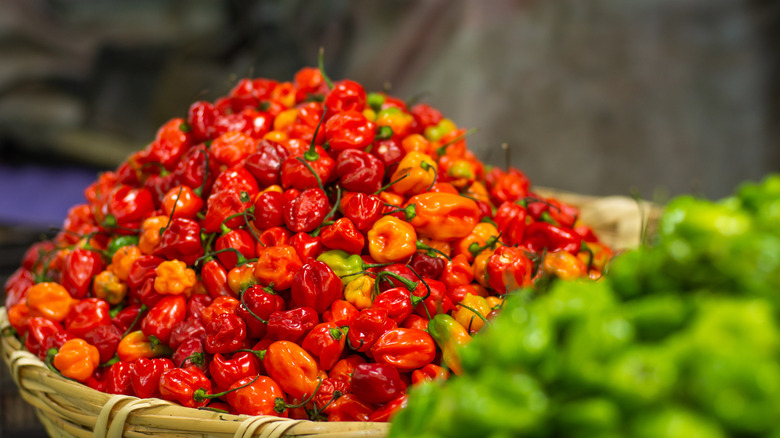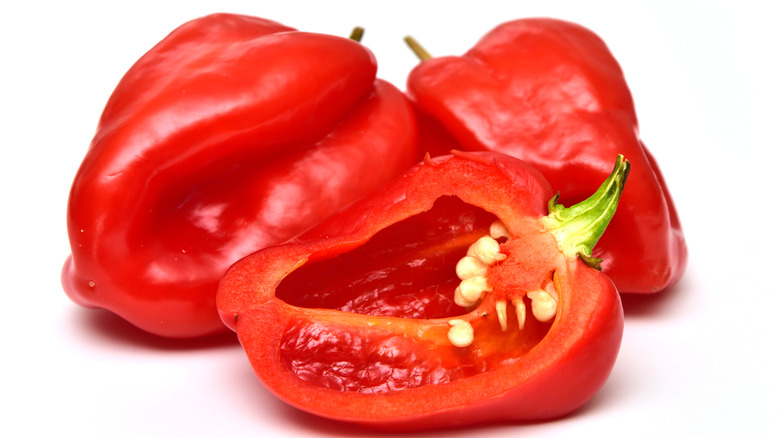What Is A Habanero And How Do You Use It?
Some like it hot. Some like it really hot. For anyone that falls into the latter group, habanero chili peppers are what My Spicer refers to as the hottest edible chili pepper in existence, ranging anywhere from 100,000 to 600,000 Scoville units. While there are a plethora of habanero varieties being grown, the typical habanero is a small red or orange pepper measuring between 1 to 2 inches in both width and height, according to Chili Pepper Madness. But don't mistake its physical proportions with the size of its punch.
Though both are fairly common peppers, habaneros are estimated to be about 45 times spicier than their chili pepper cousin, the jalapeño. And because of this mix of unique flavor and outright colossal heat, habaneros are heavily featured in salsas and hot sauces. It even lends itself to drinks in Mexico, where they're soaked in bottles of mezcal or tequila to give your drink an extra, extra kick.
The strange origins of the habanero
Like so many myths and origin stories, that of the habanero has a number of versions, including the strange way its species — Capsicum chinense — got its name. Habanero Madness describes the episode of a Dutch physician gathering different types of plants during the 1770s. And for reasons that are unclear, he named the plant type to which habaneros and scotch bonnets belong "capsicum chinense," believing their origin Chinese. But what about the habanero itself?
According to Nature's Produce, while the habanero is practically synonymous with Mexico and grown primarily on the Yucatán peninsula, the habanero — like all chili peppers — originated around the Amazon basin in South America before finding its way up to places like Mexico and the Caribbean islands. The habanero, in particular, is believed to have originally been cultivated in Cuba before coming to Mexico, eventually taking the name of its capital city. Indeed, Habanero translated to English means "from Havana."
How to eat habanero peppers
If you're a fan of the heat, there are an almost infinite number of ways to utilize that spicy little pepper ball known as the habanero. While you can make drinks or jellies or simply spice up a sauté, one of the most traditional uses of the habanero is spicy red salsa. Mexican Food Journal suggests one simple recipe still used in Yucatán — where they're produced — that combines the pepper with some tomatoes, onions, and apple cider vinegar.
When habaneros come to mind, one often thinks about spicy, luscious things like hot sauces or salsas, but there's one condiment that may seem a little outside of the box when it comes to habaneros. Chili Pepper Madness proposes a very simple but very delicate way to utilize these sweet and spicy peppers — habanero jam. Thinking about it, it makes perfect sense. Though more typical jams and jellies like strawberry and grape are far from spicy, habaneros still provide a certain sweetness and all the seeds you'd normally find in these products.
How to dial back the spice on habaneros
While some people absolutely adore the intense heat that typically comes along with eating a habanero, there are those of us who prefer the flavor over the fire when it comes to this famous chili pepper. For this, Bon Appetit employs a little-known secret to make habaneros less spicy and a little more palatable, both flavor and heat-wise. And the best part is that you're giving just as much life to the pepper as you're taking away. The trick? Soaking them in alcohol.
Alcohols like tequila, whiskey, or vodka are actually perfect for taking the heat out of habaneros. While it may give it a different kind of kick, the actual distinct flavor of habaneros tends to come out from behind the wall of heat that is so closely associated with them. Of course, there will still be some spiciness to them whether you take the pith and seeds out or not, but this method will actually be able to show you that sweet flavor that they hide.
Habaneros are hot, but how hot?
Upon hearing the word "habanero," most people think of words and phrases like "hot," "fire," and "tears pouring out." But, of course, habaneros are only one of many types of chili and compare very differently to the plethora of different hot peppers on the Scoville scale. According to Pepperhead, the capsaicin level of a habanero ranges from 100,000 to 350,000 Scoville Heat Units. Compared to something like a ghost pepper or Carolina reaper, which have SHU's that range in the millions, habaneros might not look so hot.
But don't be fooled. Habaneros are rated to be anywhere from 12 to 100 times hotter than your average jalapeño pepper. If you're one of those people who tend to think jalapeños aren't particularly spicy, just consider what touching a habanero can do to bare skin. Notably, it's recommended to use latex gloves when dealing with habaneros, as the oils that they contain can irritate human skin, to say nothing of the biting sensation they can produce when they come in contact with your eyes. While they may not be at the top of the Scoville scale, habaneros definitely can hold their own in the heat game.
The many health benefits of habaneros
Habaneros may bring images of cartoonish pain to the mind — flames shooting out of your mouth and steam pouring from your ears. But the truth of the matter is eating habaneros has numerous benefits that might outweigh the burning sensation on your tongue and lips. According to Choice Farms, habaneros, ironically, act as anti-inflammatories with properties that help get rid of migraines, headaches, and general pain. Why? The capsaicin helps to lower the number of pain signals transmitted to our brains. And this is only one of many health benefits the habanero can deliver.
Rich in antioxidants, habaneros can help to prevent and reduce a number of life-threatening maladies. Among being a strong tool against diabetes and cardiovascular diseases, habaneros can even help to kill and stop the growth of 40 different types of cells that are linked to various cancers. According to WebMD, capsaicin changes the way in which certain genes act. So while the heat may be a deterrent for some, remember: that same capsaicin also deters in a good way.
Where to buy habaneros
Now, where on Earth do you obtain these spicy, sweet, health-promoting fire peppers? According to Pepper Scale, just about anywhere. While you may not find some of the habanero's spicier kin, the popularity of this little ball of fire means it's commonly found in produce aisles of grocery stores. Usually, it's not too far from its sweeter cousin, the bell pepper. And if you're a super heat junkie, there are numerous hot sauces with habanero you can likely find grocery stores. If not, they are readily available over the internet.
Then there are those with green thumbs. If you want to try your hand at growing a some nice habaneros of your own, as always, you can find seeds on the internet and in most gardening centers well-stocked on seeds. And one of the best things about growing your own habaneros is whether you have a garden or you just want to grow them in containers, this hot pepper grows with relative ease.
